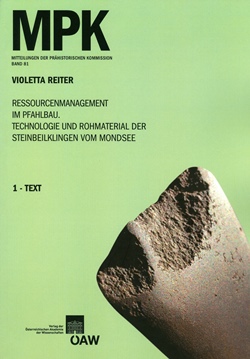In den 1870er Jahren wurden in den oberösterreichischen Salzkammergutseen Pfahlbausiedlungen entdeckt. Matthäus Much, Pionier der österreichischen Urgeschichtsforschung, barg tausende Artefakte aus der in 3–4 Meter Tiefe am Seeboden erhaltenen Pfahlbausiedlung „See“ am Mondsee. Besonders sind die 5000 Jahre alten Überreste von Organischem – wie Lebensmittel, Schnüre, Holzartefakte – hervorzuheben. Die verzierte Keramik wurde als Mondsee-Typus bekannt. Die frühesten Spuren von Kupferverarbeitung im Ostalpenraum belegen die Siedlungstätigkeit in der Kupferzeit. Daneben bieten über 400 Steinbeilklingen Einblick in das handwerkliche Geschick der Bewohner des Salzkammergutes zu „Ötzis“ Zeit. Die Steinbeilklingen, die in Holzholme geschäftet Universalwerkzeuge und wirkungsvolle Waffen darstellen, sind Gegenstand dieser Arbeit. Sie werden dem Leser metrisch und formanalytisch in Form von Diagrammen und Statistiken nahegebracht. Aufgrund von Produktions- und Gebrauchsspuren können die Herstellung einer Beilklinge, Reparatur nach Beschädigung und Materialausnutzung abhängig von der Gesteinsart rekonstruiert werden. Um den Lebensraum zu beschreiben, ist es von besonderem Interesse, über die Lagerstätten der Gesteine der Beilklingen Kenntnis zu haben. Abschließend werden petrologische Untersuchungsmethoden aus archäologischer Sicht vorgestellt, die der Erforschung der potentiellen Lagerstätten dienlich sind. Der reich bebilderte Textband wird von einem ausführlichen Katalog ergänzt.
In the 1870s, pile dwellings were discovered in Upper Austria’s Salzkammergut. Matthäus Much, a pioneer explorer of Austrian prehistory, recovered thousands of artefacts from the bottom of Lake Mondsee, where remnants of a Neolithic pile dwelling had survived 3–4 meters below the surface. Of these the organic relicts conserved under water for over 5000 years, such as food, pieces of twine and wooden artefacts, are especially noteworthy while the kind of decorated ceramics discovered there became the key feature defining the regional Mondsee-culture. Finds pertaining to the earliest procession of copper in the Eastern Alps are evidences of settlement activity in the Copper Age, as well. Apart from these artefacts, more than 400 stone axes were recovered. They provide an impressive insight into the technical skills of the Salzkammergut’s settlers of the Iceman’s time. Fitted into wooden shafts, they were universal tools as well as effective weapons. These stone axes are the subject of this thesis. They were analysed in form and size. The acquired data in this process was then evaluated and is presented in the form of diagrams and statistics. Based on the traces of manufacture and use, it can be reconstructed as well: process of production, repairing after damage and the utilisation of material depending on the type of raw material. To describe the living area it is important to have the knowledge of the location of raw material deposits. Accordingly, the petrological methods especially useful in archaeology for finding the location of rock deposits are introduced in conclusion. The richly illustrated text component is completed by an extensive catalogue.



 Home
Home


 Print
Print
 References
References
 Share
Share